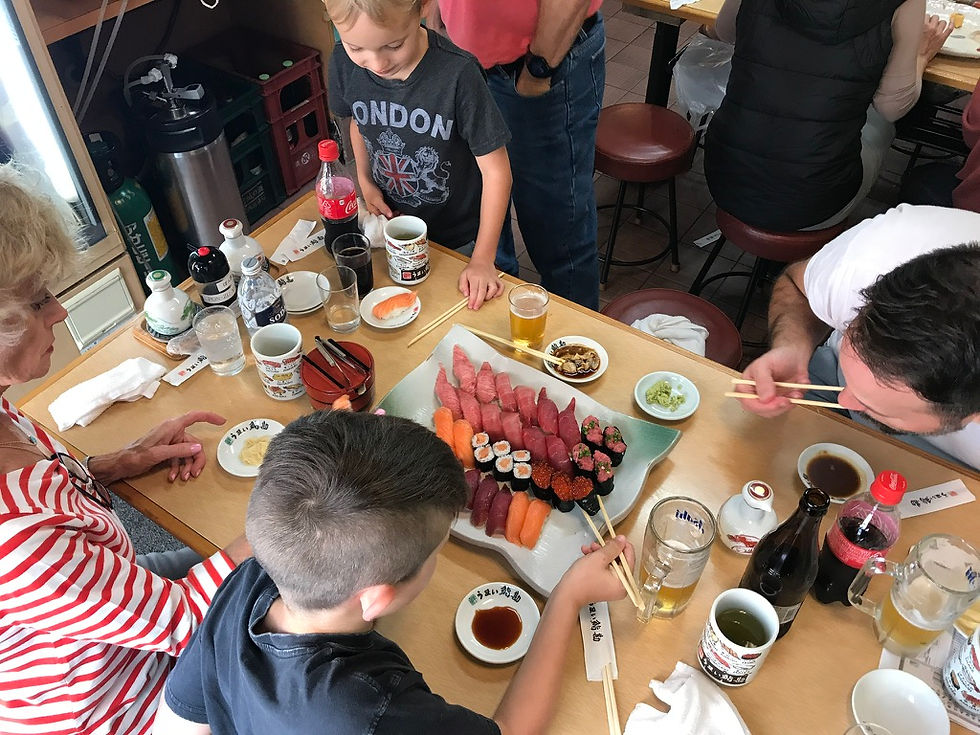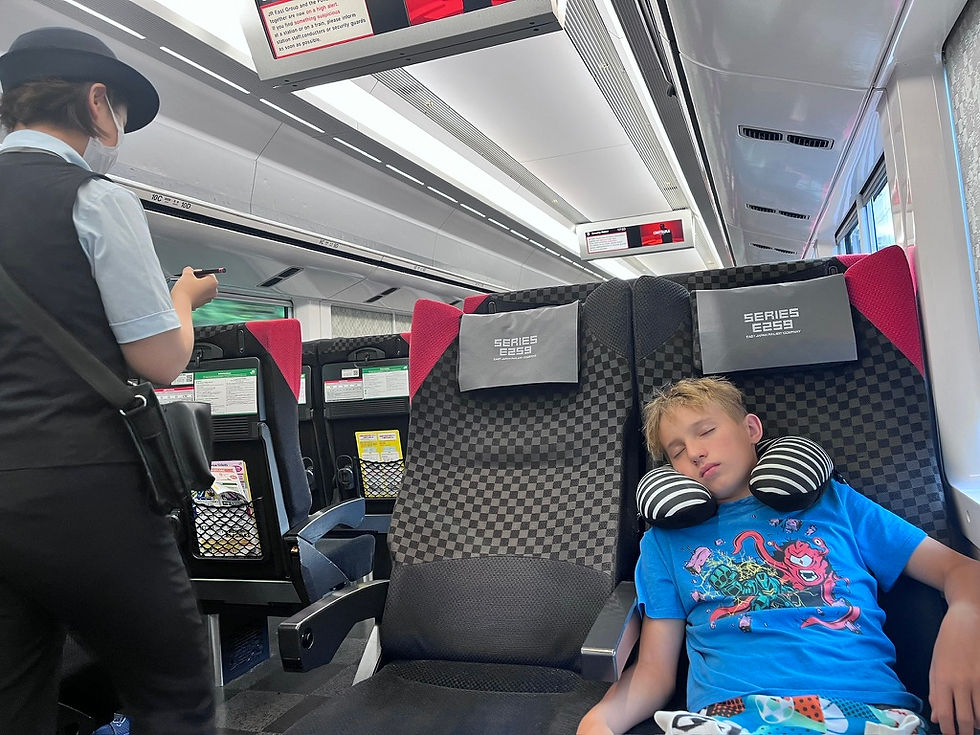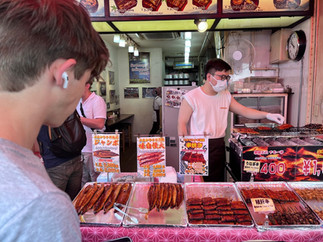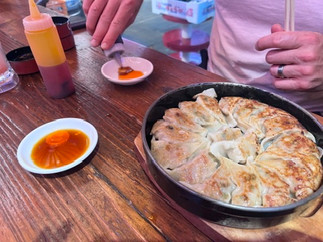Japan Travel Recommendations- Tokyo: Our Top 6 Experiences, Plus Local Travel Advice
- Brooke Amidei

- Sep 3
- 15 min read
Updated: Sep 10
Tokyo is a one of a kind city that will beckon you in with delicious food, famous sights and wonderful people...a lot of them! Our family has been lucky enough to visit a handful of times both when we were expats living in Hiroshima, and on trips since that time and there is always something new to discover. Below are our recommendations that we would share with any friends and family visiting and our personal highlight list.
I want to say right out of the gate, that one of our Japanese friends, who is an incredible planner, gave us this big picture advice for our latest trip to Japan and it helped narrow down what to do in Tokyo vs. other areas in Japan.
Big picture- do the old stuff in Kyoto and modern, funky stuff in Tokyo.
Top 6 Must Have Experiences in Tokyo
1
Omoide Yokocho Shinjuku Alleyway
My #1 highlight of our trips to Tokyo was the Omoide Yokocho Shinjuku Alleyway, absolutely!

If you want to feel like you’ve stepped into the Tokyo of old movies—lanterns glowing, sizzling yakitori on the grill, and alleyways just wide enough for two people to squeeze past-head to Shinjuku’s alleyways at night (Shinjuku is one of Tokyo's most famous neighborhoods or wards).
First a quick translation for you: Yokocho literally means “side street” or “alley,” but in Tokyo travel-speak, it usually refers to lively food-and-drink alleys where you can hop between ramen shops, izakayas (Japanese pubs), yakitori stands, and tiny bars.
There are two main "yokocho"/alleyways in the Shinjuku neighborhood (or ward) travelers should know:
Omoide Yokocho (“Memory Lane”) – This is the most famous food alley in Shinjuku. It’s where you’ll find smoky little stalls grilling yakitori, tiny ramen shops, and izakayas (Japanese pubs). It feels lively but approachable for visitors—it’s one of the classic “you can’t miss it” Tokyo food experiences. All photos are here, and the highlight of our personal vacation is from this particular yokocho.
Golden Gai – This is the most famous bar alley in Shinjuku. Picture six narrow lanes packed with more than 200 teeny-tiny bars, most seating fewer than 10 people. Each bar has its own theme—jazz, punk rock, retro Japan, even horror movies. Some are very local-only, but many welcome visitors, especially if they post menus in English. This one is on our list for our next trip without the kids.
Best time to go: After dark, usually from 7 p.m. onward, when the lanterns are glowing and the food stalls are in full swing. It’s especially lively on weekends, and by lively, I mean packed!
What to eat & drink there:
Yakitori skewers (classic Tokyo street food).
Bowls of ramen or soba from tiny kitchens.
Sake, shochu, or a Japanese highball (whiskey + soda).
Fresh Japanese roasted oysters
What to expect: These alleyways are all about atmosphere- intimate, bustling, sometimes smoky, and totally unforgettable. Don’t go in expecting fine dining; go for the charm, the people-watching, and the feeling that you’ve slipped into a secret side of Tokyo.
Here are other alleyways you may want to have on your radar by neighborhood (ward):
Famous Alleyways in Tokyo
Shinjuku (Omoide Yokocho + Golden Gai)– Food stalls, smoky grills, and lively bars. These are the most famous internationally and are must-sees if you’re in Shinjuku. (both listed above.)
Shibuya (Nonbei Yokocho, “Drunkard’s Alley”)– A hidden little stretch near Shibuya Crossing with tiny bars and izakayas. Much smaller than Shinjuku’s versions, but with a local, cozy charm.
Ebisu Yokocho– A covered alley filled with a cluster of izakayas serving everything from yakitori to sashimi to sake. A great spot for bar-hopping with a younger, energetic crowd.
Harmonica Yokocho (Kichijoji)– A warren of little bars, food stalls, and vintage shops just outside Kichijoji Station. It feels like a throwback to old Tokyo and is popular with both locals and in-the-know visitors.
Ameya-Yokocho (Ueno)– Less about bars and more about shopping + street food. It’s a bustling market street where you can buy clothes, cosmetics, spices, and grab takoyaki or skewers while you walk.
The Takeaway
If you only do one: Shinjuku (Omoide Yokocho + Golden Gai) for the “classic” Tokyo alleyway experience.
If you want more: Shibuya’s Nonbei Yokocho is a fun add-on since it’s right by Shibuya Crossing.
For something local and less touristy: Ebisu or Kichijoji give you a more “everyday Tokyo” vibe.
This article was also super helpful in understanding and helping choose which alleyway we wanted to visit.

2
Tsukji Outer Market:
If you love food adventures, Tsukiji Outer Market is a must when visiting Tokyo. While the famous wholesale fish auctions moved to a new location in Toyosu, Tsukiji’s outer market has kept all its charm- and then some. Picture a maze of narrow lanes lined with tiny stalls, shops, and street-food stands where Tokyo locals and chefs still shop daily.

Best time to go: Morning is ideal, (around 8–11 a.m.)- this is when the freshest seafood and produce hit the stands, and before the lunchtime crowds arrive. Some stalls start winding down by early afternoon, so don’t go too late! Truly the earlier the better to avoid crowds. Maybe your jet lag will work in your favor?

What to see & do:
Watch expert knife work at shops selling whole tuna or delicate sashimi.
Browse stalls with Japanese teas, dried seaweed, bonito flakes, and artisanal kitchenware.
Absolutely pick up souvenirs! Especially handmade knives (some you can even engrave with your family's name is Japanese), chopsticks (again also get them engraved), or ceramics (practical and beautiful keepsakes that you'll wish you brought home more of).

What to eat:
Fresh sushi (think melt-in-your-mouth tuna or uni served minutes from the sea).
Grilled skewers of seafood or wagyu beef.
Oysters on the half shell, shucked right in front of you.
Tamagoyaki (Japanese omelet)—sweet, fluffy, and sold on a stick for easy snacking.
It’s one of those places where you’ll want to wander slowly, snack as you go, and let your nose (and curiosity) guide you. Tsukiji Outer Market isn’t just about eating- it’s about soaking up the atmosphere of Tokyo’s food culture at its most lively.
3
If you want an experience in Tokyo that feels like stepping into another universe, put teamLab Planets at the top of your list. It’s an immersive digital art museum where you don’t just look at art—you actually walk through it, wade barefoot in water with koi swimming around your feet (all created with light projections), and wander through mirrored rooms where flowers bloom endlessly around you. Every space is designed to play with your senses—you feel part of the artwork, not just a spectator.

Travel Recommendations for Visiting teamLab Planets
Book well in advance. Tickets often sell out days (and sometimes weeks) ahead, especially during peak tourist seasons. The easiest way is directly on the official teamLab Planets website.
Be prepared to go barefoot. This isn’t optional—many exhibits involve water, soft floors, or mirrored spaces. Lockers are provided for your shoes and bags.
Dress smart. Avoid short skirts or dresses (lots of mirrored floors!) and bring pants you can roll up easily for the water installations.
Go early or late. Mornings are quieter, or you can book evening slots for a moodier vibe and fewer crowds.
Location: It’s in Toyosu, just a short train ride from central Tokyo. You can pair it with a stop at Toyosu Market (the new home of the famous tuna auctions).
Timing: Plan about 1.5–2 hours inside, though you may want more if you love taking photos.
Why it’s worth it: Even in a city packed with incredible sights, teamLab Planets feels unlike anything else in the world. It’s art, tech, and wonder all rolled into one—and it’s one of those experiences that will stay with you long after your trip.
I had wanted to visit Senkyaku Banrai Toyosu Manyo Club Onsen not far from TeamLab to rest our feet, but it didn't fit into our schedule. Perhaps it will with yours?
4
If there’s one spot in Tokyo that feels like stepping straight into a movie scene, it’s Shibuya Crossing. This is the world’s busiest pedestrian scramble—an estimated up to 3,000 people cross at one time, heading in as many as seven different directions when the lights turn green. Imagine the energy of Times Square, but instead of cars and chaos, it’s this mesmerizing, perfectly choreographed wave of people flowing across the street.
We had fun both watching it from above (described more below), but of course you have to join in the chaos yourself as well.

Right above all that action sits Shibuya Sky, an open-air observation deck on top of the Shibuya Scramble Square tower. From here you get 360° views of Tokyo—including Mt. Fuji on clear days—and you can actually look down at the famous crossing you just walked through. It’s one of the best spots in the city for both photos and that pinch-me-I’m-in-Tokyo moment. We opted out of the Shibuya Sky experience and headed to the 2nd floor of Starbucks to watch the organized chaos, which is another popular option.
5
I am not a big Disney girlie, but Disney Tokyo was a once in a lifetime experience! There is something extra magical (and mindblowingly strange) about seeing all of the well known characters of your youth speaking Japanese! Japanese Cinderellas and Johnny Depp speaking in Japanese on the Pirates of the Caribbean were a highlight!!

Tokyo Disney Resort is home to both Tokyo Disneyland and the one-of-a-kind DisneySea (which is apparently incredible and unfortunately, we didn't make it there). Disneyland has all the classic charm- castle, parades, rides you know and love—while DisneySea is a more grown-up, adventurous twist with jaw-dropping lands themed around oceans, myths, and legends (think gondolas in the Mediterranean Harbor and a volcano that erupts at night).
Both have next-level popcorn flavors (soy sauce butter, anyone?) and famously polite crowds. It’s not just another theme park- it’s one of the most uniquely Japanese experiences you can have in Tokyo.
6
Mt. Fuji
No trip to Japan feels complete without seeing the iconic silhouette of Mt. Fuji, the country’s tallest peak and a UNESCO World Heritage Site. If you’re adventurous, you can actually climb it, joining streams of hikers who make it to the summit for sunrise- an unforgettable bucket-list moment.

The official climbing season runs early July to early September, when the trails are clear of snow and mountain huts are open. Since 2024, a reservation is required to hike the most popular Yoshida Trail (the one closest to Tokyo), and there’s now a small ¥2,000 fee to help with conservation. Reservations, trail info, and safety updates can be found on the Mt. Fuji Climbing Official Website.
My husband took on the challenge when we were living in Japan and it is not for the light hearted! The temperature dropped 50 degrees from the base to the peak at 12,400’. They started at 11am on a Sunday morning and reached the summit at 3am on Monday in time to watch the sunrise! They were able to get a few hours of sleep in a hut with 40 others at 10,000 vertical feet! Again, not for the lighthearted.
If you’re not up for the full climb, you can still experience Mt. Fuji with a bus trip to the 5th Station (about halfway up the mountain). Buses run from Tokyo and Kawaguchiko, dropping you off at a spot with shrines, shops, and panoramic views- perfect for feeling the atmosphere of Fuji without the full hike. We tried this ourselves and unfortunately had terrible weather so we didn't see any of Mt. Fuji and it was essentially just a long bus ride in the rain and haze.


I've also heard some of the best ways to enjoy Fuji are from the ground. You can take a day trip to the Fuji Five Lakes region for stunning views, ride a boat across Lake Kawaguchi, or relax in a traditional hot spring (onsen) with the mountain as your backdrop. Even a ride on the bullet train between Tokyo and Kyoto gives you a postcard-perfect glimpse if the skies are clear.

Whether you climb, hike nearby, or just admire it from afar, Mt. Fuji is one of those pinch-me sights that makes you stop and remember you’re really in Japan.
A few other's worth mentioning categorized in to Old, Traditional Japan and Modern Japan.
Old, Traditional Japan Highlights:
A historic district in Tokyo where the past still whispers through narrow lanes, traditional shops, and the majestic Senso-ji Temple. Tokyo’s oldest and most beloved Buddhist temple, founded in 645 AD, dominated by the iconic red lantern of Kaminarimon and buzzing with pilgrims and shoppers along Nakamise-dōri.
Nestled in the heart of Tokyo behind moats and stone walls, this is the Emperor’s residence; guided tours of its serene grounds and iconic Nijubashi Bridge can be reserved in advance.
Sumo in Tokyo
Experience Japan’s national sport by catching live sumo tournaments or visiting a morning training stable to watch rikishi (wrestlers) practice up close.

Sumo Tournaments- Tokyo hosts major sumo tournaments in January, May, and September at the Ryogoku Kokugikan Arena. Official Schedule
Morning Sumo Practice- Witness sumo wrestlers' rigorous training at various sumo stables in Tokyo. Morning Practice Tour Rakuten Travel Experiences
Sumo Stable Visits- Observe daily routines and training sessions of sumo wrestlers in their training stables. Arashio Beya Training Schedule
A hands-on museum in Asakusa where visitors can don samurai armor, toss shuriken, and learn warrior techniques—all in a fun, immersive setting.

Discover Harmonica Yokocho, a nostalgic alleyway in Kichijoji filled with tiny eateries and bars. This charming spot offers a glimpse into Tokyo's post-war era and is perfect for an evening out.
Modern Japan:
Experience Tokyo like never before by driving a go-kart through the city's streets in costume. While the original Mario Kart tours have been discontinued, similar experiences are still available. Dress up as your favorite character and cruise through iconic neighborhoods.
To drive a real-life Mario Kart in Tokyo, participants must be at least 18 years old and possess a valid driver's license recognized under Japanese traffic law. This includes:
A valid Japanese driver's license
An International Driving Permit (IDP) issued under the 1949 Geneva Convention, accompanied by your original domestic driver's license
For residents from certain countries (e.g., Switzerland, Germany, France, Taiwan, Belgium, Estonia, Monaco), an official Japanese translation of their driver's license from an authorized organization, along with the original license
For U.S. residents, a SOFA License or a combination of a valid Active Military ID with a valid state-side driver's license.
For more detailed information and to book a tour, you can visit JapanKart or Shibuya Kart.
Visit the Tokyo Metropolitan Government Building for panoramic views of the city from its free observation decks. Located in Shinjuku, it's an excellent spot for sightseeing without the crowds.

Dive into Tokyo's tech and pop culture hub, Akihabara, known for its electronics shops, anime and manga stores, and maid cafés. It's a paradise for tech enthusiasts and pop culture fans alike.

Explore Harajuku, Tokyo's fashion district, famous for its eclectic street style and vibrant youth culture. Takeshita Street is lined with boutiques, cafés, and shops offering the latest trends. Known for being “kawaii” teen central and known for street Takeshita Dori.
Experience the laid-back atmosphere of Shimokitazawa, known for its vintage shops, indie cafés, and live music venues. It's a haven for creatives and those seeking a more relaxed side of Tokyo.
Visit Odaiba, a futuristic man-made island in Tokyo Bay, featuring attractions like teamLab Borderless, the life-sized Unicorn Gundam statue, and shopping malls. It's a blend of entertainment, technology, and leisure.
Unique Food Experiences
Of course the entire time you are in Tokyo you are going to be eating and drinking some of the best food and drink of your entire life. Every meal. Even if you are at a convenience store. For all of the details of Japanese food, check out our article here, and start salivating. In the meantime, I wanted to point out some Tokyo-specific unique dining experiences.
Tokyo isn’t just about what you eat- it’s how you eat it. The city is famous for its theme restaurants, from the quirky and over-the-top Robot and Ninja experiences to the sleek, stunning rooftop bars (I personally wanted to explore more of the Tokyo rooftop bar scene, but it will have to be on a kid-free trip). Want something truly Tokyo-only? Try a kawaii monster café (all rainbow food and neon vibes) or animal cafe. From whimsical to glamorous, Tokyo turns dinner into an unforgettable adventure.
Here are a few for you adventurous eaters. Do check reviews however as some are quite expensive and jury is out on if they are really worth your valuable vacation time.
Ninja Tokyo – Dine in a hidden ninja village where waiters perform tricks and serve creative Japanese dishes.
Robot Restaurants – think robot baristas and futuristic lunch experiences.
Two Rooms Grill & Bar – Sleek rooftop spot in Omotesando with incredible city views and craft cocktails.
New York Grill & Bar (Park Hyatt Tokyo) – Iconic rooftop bar from the movie Lost in Translation with skyline views of Tokyo and Mt. Fuji.
Kawaii Monster Café (Harajuku) – A psychedelic, rainbow-colored restaurant where the food is as playful as the décor.
Harry Hedgehog Café – An animal café where you can sip tea while cuddling with adorable hedgehogs (and yes, there are also owl, cat, and capybara cafés around Tokyo!).
Travel Recommendations

Pack Light!
This is not the trip to jam pack a giant suitcase. First of all, you will be lugging that sucker all through the city and it just isn't that easy, or necessary. You are going to want to have a great pair of tennis shoes and some good travel layers, but keep it small. The hotel rooms are much smaller than we are accustom to here in the US, so you won't have that much room for your regular sized suitcase even once you haul it there! Pack smart and pack light.

Japan Rail Pass
If you’re planning a trip to Japan- especially if Tokyo is just one stop on your itinerary- you’ll want to know about the Japan Rail Pass (JR Pass). Think of it as an all-access ticket for trains across Japan’s national railway network.
Instead of buying individual train tickets every time you want to hop from Tokyo to Kyoto, Osaka, Hiroshima, or even just zip around the Tokyo area, you purchase the JR Pass for a set number of days (7, 14, or 21). During that time, you can ride most trains—including the famous Shinkansen “bullet trains”—without paying extra each trip.

Why it’s worth it:
Huge savings if you’re taking longer trips outside Tokyo. For example, a round-trip bullet train ride from Tokyo to Kyoto costs almost the same as a 7-day JR Pass.
Convenience- no need to buy tickets each time; just flash your pass and go.
Flexibility- it covers not only high-speed trains but also many local trains, buses, and even ferries in the JR network.
Important note: The JR Pass is generally most valuable if you’re traveling beyond Tokyo. If your whole trip is just exploring Tokyo itself, a local transit card (like a Suica or Pasmo) will be a better fit. But if you’re doing the classic Japan loop—Tokyo → Kyoto → Osaka (maybe Hiroshima)—the JR Pass pays for itself and makes travel stress-free.

How & Where to Purchase the Japan Rail Pass
You can buy the JR Pass online (either directly from the official JR Pass site or through authorized travel agencies/websites). When you buy it before your trip, you’ll either:
Get a voucher (called an Exchange Order) mailed to you (if you buy through a third-party site). You’ll then bring that voucher to Japan and swap it for the real pass.
Buy directly through the official JR Pass site, in which case you’ll still pick up the physical pass once you arrive in Japan but won’t need a mailed voucher.
Technically, you can buy the JR Pass after you arrive in Japan, but it’s more expensive that way—so almost everyone saves by purchasing ahead of time.
Do You Still Have to Visit the JR Office?
Yes, you do. Even if you’ve prepaid, you still have to stop by a JR exchange office once you land in Japan (you’ll find them at major airports like Narita or Haneda and at big train stations). At that office, you’ll:
Hand over your voucher (if you bought through an agency) or show your purchase confirmation.
Pick the start date for when you want your pass to begin (super helpful if you’re staying in Tokyo for a few days before heading out on the trains).
Get your actual paper JR Pass, which you’ll show when boarding trains.

Smart Strategy for Travelers
Buy it before your trip- you’ll save money and avoid scrambling when you land.
Don’t activate it right away if you’re staying put in Tokyo at first. Use a Suica/Pasmo card for local trains in the city, then activate your JR Pass the day you start your bigger adventures (Kyoto, Osaka, etc.).
Exchange your voucher at the airport when you land- it saves you the headache of trying to find the right office later when you’re rushing for a train.
Bus Tour?
We personally aren't big on bus tours, but I gotta give it to them, they can be a great way to see a lot of stuff in a short amount of time without any worry about the transportation. This can also be a great way to see Mt. Fuji (see above). This particular company came recommended by a Japanese friend.
Where to Stay
For our most recent trip to Tokyo it was recommended to us by a Japanese friend to stay near the Tokyo Station, mainly because we had limited time and wanted to see a lot. I absolutely urge you to take full advantage of the awesome public transportation in Japan/Tokyo. Truly it is one the main events or sights of Japan, and it is so reliable and thorough. It might be frustrating to figure out at first, but it is well worth it!
If you stay near Tokyo station, the Yurakucho neighborhood is a close enough walk, and the yakitori/nomiya places under the train tracks have a similar feeling of the famous Shinjuku alleyway, and while crowded, won’t be as slammed as Shinjuku’s.

We stayed at the Hotel Metropolitan Tokyo Marunouchi right next to/above the Tokyo Station and were very pleased. It was super conveniently located and we especially appreciated that when we took the train from the airport to our hotel. We were super tired and ready to drop our bags and crash. Word of warning- even though this was a super conveniently located hotel, it is SO busy and there are SO many levels to Tokyo Station, we still had trouble at times finding our way. Just something to know going into your trip.
A Japanese friend also absolutely recommended staying in the Shibuya area that has plenty of hotels and is near to Shinjuku, and so on.
If you are planning a trip to Tokyo or any other area of Japan, you should absolutely take a look at "An Expat's Tips for Visiting Japan" for all of the details on travel, food, and how to best experience this awesome country.
And I'm going to go ahead and say it... Tokyo is on the bottom of my list of favorite places to visit in Japan. I would put Kyoto, Hiroshima and Osaka above Tokyo any day of the week.
Looking for more great content like this? Make sure you're signed up for the FREE Babble Newsletter: Ideas, advice, quick tips, and time-savers delivered straight to your inbox each week.
Share this story today!













































Comments